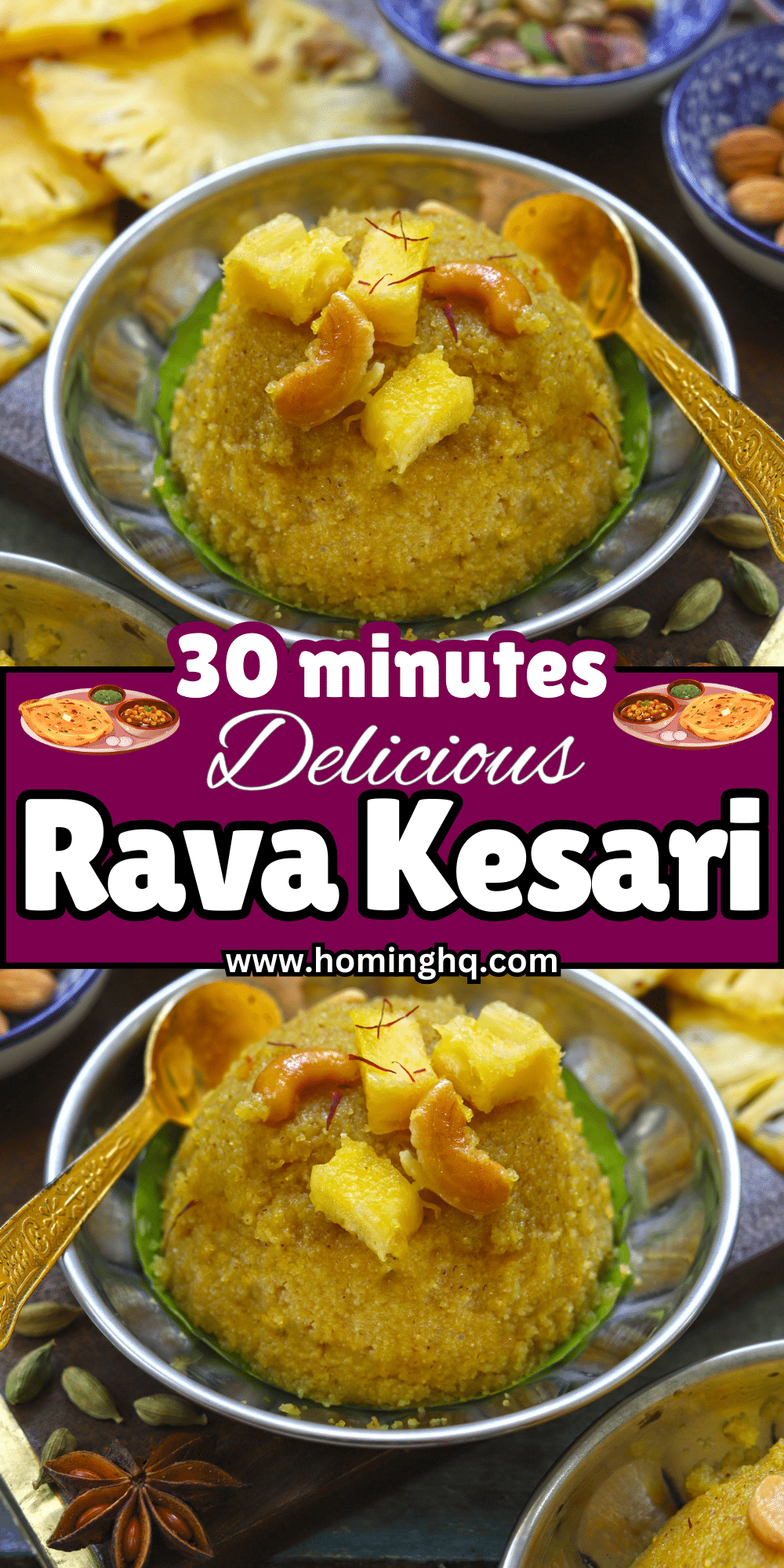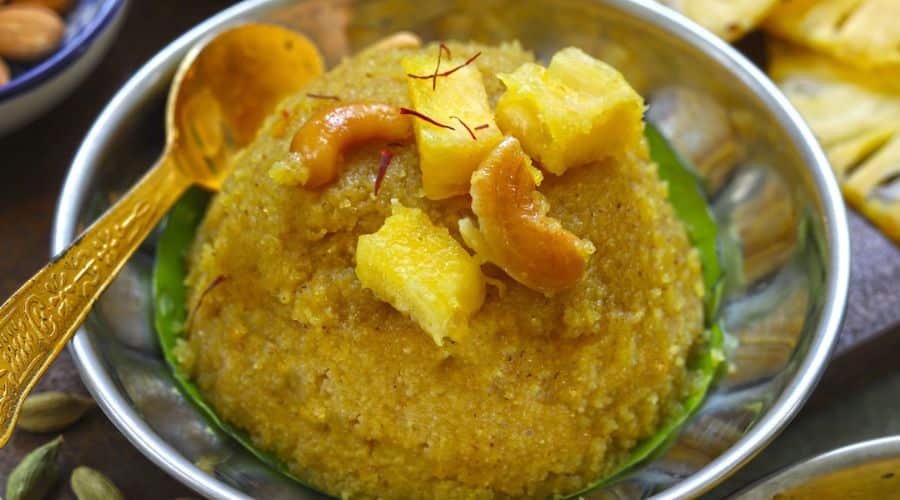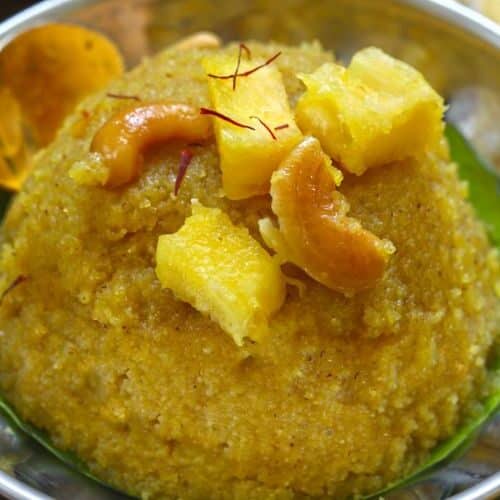All products are selected by our editorial team for quality. If you buy through our links, we may earn a small commission at no extra cost to you.
Rava Kesari is a beloved South Indian dessert known for its rich, buttery texture and delicate saffron-infused sweetness.
Made with semolina (rava), sugar, ghee, and a hint of cardamom, this dish is often prepared during festivals, religious ceremonies, and special occasions.
The name “Kesari” comes from its vibrant orange or saffron hue, achieved by adding a pinch of food color or natural saffron strands.
Though commonly served as a simple yet indulgent sweet, Rava Kesari has several regional variations, such as Pineapple Kesari or Milk Kesari, making it a versatile treat loved across India.
Now, let’s dive deeper into what makes this dish special and how you can make the perfect Rava Kesari at home.

What is Rava Kesari?
A Traditional South Indian Delight
Rava Kesari is a semolina-based sweet dish cooked with sugar syrup, flavored with cardamom, and enriched with ghee.
It is a staple in Tamil Nadu, Karnataka, and Andhra Pradesh and is often served as part of a festive meal or prasadam (offering) in temples.
How is Rava Kesari Different from Suji Halwa?
While Rava Kesari is similar to North India’s Suji Halwa, the key differences lie in the preparation and texture.
Suji Halwa is often softer and made with milk, whereas Rava Kesari has a firmer, more structured consistency with an added hint of saffron color.
Ingredients for Rava Kesari
To make a delicious Rava Kesari, you will need the following ingredients:
- ½ cup Semolina (Rava/Sooji) – The main base, which gives the dish its grainy texture.
- ½ cup Sugar – For the perfect level of sweetness.
- 1 ½ cups Water – Helps cook the semolina evenly.
- ¼ cup Ghee – Adds richness and enhances the flavor.
- 10-12 Cashews – Fried in ghee for crunch.
- 2 tablespoons Raisins – Adds a mild sweetness.
- ¼ teaspoon Cardamom Powder – Provides a fragrant aroma.
- A pinch of Saffron Strands or Orange Food Color – Gives the dish its signature golden hue.
Optional Ingredients:
- ½ cup Milk – For a richer and creamier texture.
- 2 tablespoons Pineapple Puree – For a fruity twist.
Step-by-Step Guide to Making Rava Kesari

Step 1: Roasting the Semolina
- Heat 1 tablespoon of ghee in a pan and add the semolina.
- Roast it on low flame until it turns light golden and emits a nutty aroma. Keep stirring to prevent burning.
Step 2: Preparing the Sugar Syrup
- In a separate saucepan, heat water and bring it to a boil.
- Add sugar, cardamom powder, and saffron strands (or food color). Stir until the sugar dissolves completely.
Step 3: Cooking the Rava
- Slowly pour the hot sugar syrup into the roasted semolina while continuously stirring to avoid lumps.
- Mix well and let it cook for 3-4 minutes until the mixture thickens.
Step 4: Adding Ghee & Nuts
- Add the remaining ghee, followed by fried cashews and raisins.
- Stir everything well until the Kesari leaves the sides of the pan.
Step 5: Final Touch & Serving
- Remove from heat and let it rest for a couple of minutes.
- Serve warm, garnished with more nuts if desired.
Pro Tips for Perfect Rava Kesari
- Always roast the rava properly – This prevents a sticky, lumpy texture.
- Use the right water ratio – Too much water makes it mushy, too little makes it dry.
- Add sugar only after the rava is cooked – This ensures smooth consistency.
- Do not skimp on ghee – It enhances flavor and gives Kesari its glossy finish.
- Stir continuously while adding sugar syrup – This prevents lump formation.
Storage and Shelf Life
- Room Temperature: Stays fresh for up to 24 hours in an airtight container.
- Refrigeration: Can be stored for 2-3 days but should be reheated before serving.
- Reheating Tip: Add a teaspoon of ghee while reheating to restore its softness.
Common Mistakes to Avoid
- Not roasting the rava enough – Leads to a raw taste and sticky texture.
- Adding sugar too early – Can make the Kesari clumpy and undercooked.
- Using too much or too little water – Alters the consistency drastically.
- Cooking on high heat – Rava needs slow cooking for the best results.
Conclusion
Rava Kesari is a simple yet indulgent Indian dessert that requires just a few ingredients but delivers a rich and flavorful experience.
Whether made for a festival, a special occasion, or simply to satisfy a sweet craving, this dish is always a crowd-pleaser.
Now that you have the perfect recipe, try making Rava Kesari at home and share your experience.
If you have any questions, check out the FAQ section below!
Frequently Asked Questions
1. Can I make Rava Kesari without food color?
Yes! You can use saffron strands soaked in warm milk to achieve a natural golden hue instead of artificial food color.
2. Why does my Rava Kesari turn sticky?
This usually happens when the rava is not roasted well or if too much water is used. Always roast the rava properly and stick to the recommended water ratio.
3. Can I use milk instead of water for a richer taste?
Absolutely! Replacing water with milk gives the Kesari a creamier texture and enhances the flavor.
4. How do I make pineapple Kesari?
To make pineapple Kesari, add ¼ cup of pineapple puree while preparing the sugar syrup. You can also add small pineapple chunks for extra flavor.
5. Can I prepare Rava Kesari in advance?
Yes, you can make it ahead of time and store it in an airtight container. Reheat with a little ghee or warm water to restore its softness before serving.
Would you like me to tweak anything or add more details?

Rava Kesari
Equipment
- 1 Heavy-bottomed pan or kadai
- 1 Wooden spoon or spatula
- 1 Saucepan
- 1 Measuring Cups and Spoons
- 1 Mixing Bowl
Ingredients
- ½ cup Semolina Rava/Sooji
- ½ cup Sugar
- 1 ½ cups Water
- ¼ cup Ghee
- 10-12 pieces Cashews
- 2 tbsp Raisins
- ¼ tsp Cardamom Powder
- A pinch – Saffron Strands or orange food color
- Optional ½ cup Milk (for richer texture)
Instructions
Step 1: Roast the Semolina
- Heat 1 tablespoon of ghee in a heavy-bottomed pan on low flame.
- Add semolina (rava) and roast until it turns light golden brown and emits a nutty aroma. Keep stirring to prevent burning. Transfer to a plate and set aside.
Step 2: Prepare the Sugar Syrup
- In a separate saucepan, boil water and add sugar, cardamom powder, and saffron strands (or food color). Stir until the sugar dissolves completely.
Step 3: Cook the Rava
- Gradually pour the hot sugar syrup into the roasted rava while continuously stirring to prevent lumps.
- Stir well and cook for 3-4 minutes until the mixture thickens.
Step 4: Add Ghee & Nuts
- In another pan, heat remaining ghee, then fry cashews and raisins until golden.
- Add the fried nuts along with the ghee into the Rava Kesari mixture. Stir well.
Step 5: Serve and Enjoy
- Once the Kesari starts leaving the sides of the pan, remove from heat.
- Serve warm, garnished with extra nuts if desired.
Notes
- For a softer texture: Replace water with milk or use a 50-50 combination of both.
- To avoid lumps: Stir continuously while adding the sugar syrup to the roasted rava.
- For added flavor: You can mix in pineapple puree, banana puree, or coconut for unique variations.
- Shelf life: Rava Kesari stays fresh at room temperature for a day or in the refrigerator for up to 3 days.

